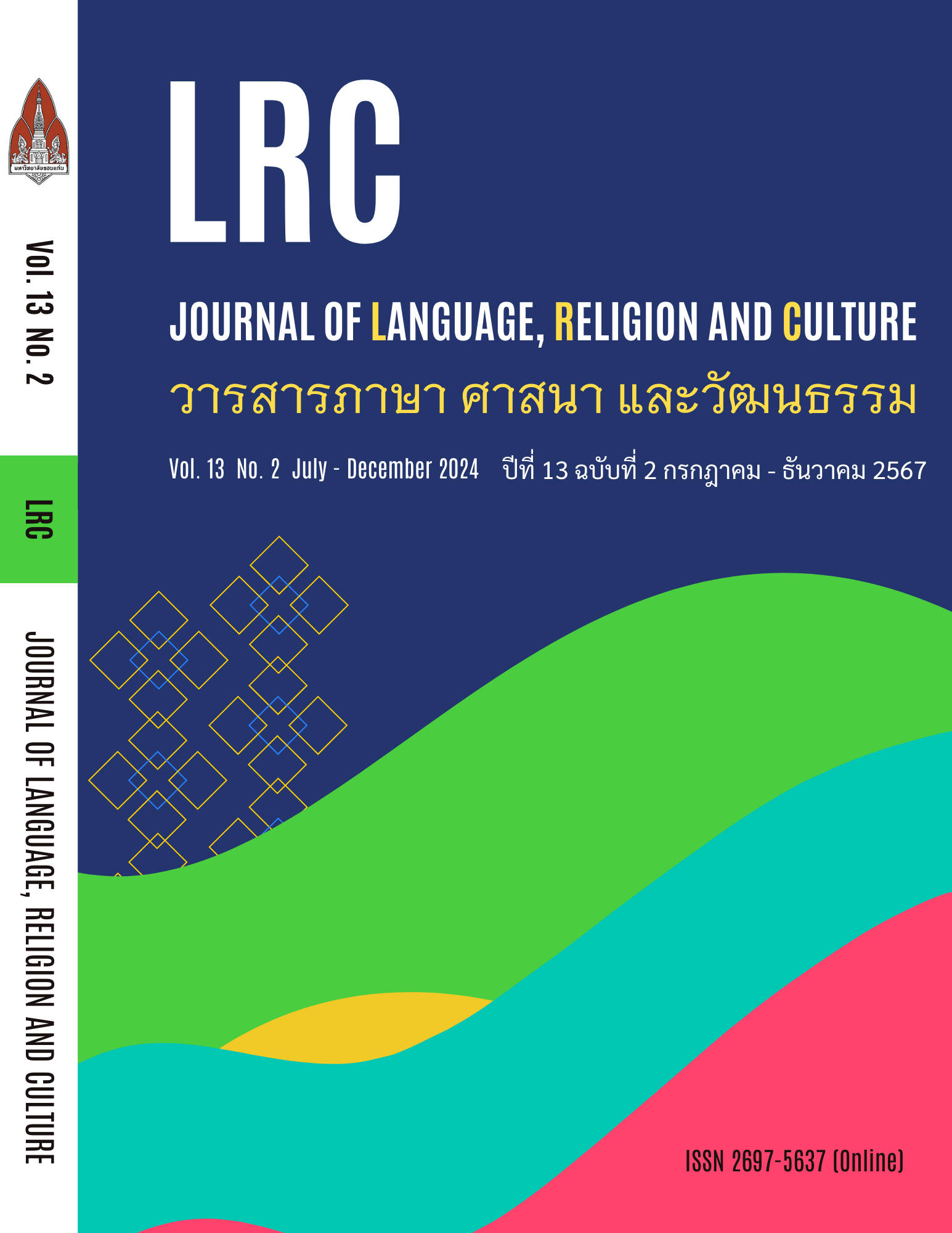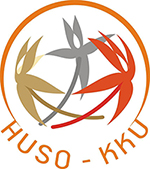การศึกษาการใช้ภาพพจน์ในนวนิยายจีน เรื่อง “กุหลาบแดงกับกุหลาบขาว”
การศึกษาการใช้ภาพพจน์ในนวนิยายจีน เรื่อง “กุหลาบแดงกับกุหลาบขาว”
คำสำคัญ:
ภาพพจน์, นวนิยายจีน, “กุหลาบแดงกับกุหลาบขาว”บทคัดย่อ
บทความวิจัยนี้มีวัตถุประสงค์เพื่อศึกษาการใช้ภาพพจน์ในนวนิยายจีนเรื่อง “กุหลาบแดงกับกุหลาบขาว”(《红玫瑰与白玫瑰》)ซึ่งเป็นวรรณกรรมจีนสมัยใหม่ที่มีชื่อเสียง ประพันธ์โดย จาง อ้ายหลิง มีวิธีดำเนินการวิจัยคือการรวบรวมข้อมูลที่ปรากฏในนวนิยายจีนเรื่อง “กุหลาบแดงกับกุหลาบขาว” และวิเคราะห์ข้อมูลภายใต้กรอบแนวคิดของดวงใจ ไทยอุบุญ ที่แบ่งภาพพจน์ที่ใช้บ่อยออกเป็น 14 ชนิด จากนั้นนำเสนอผลการศึกษาวิเคราะห์ในรูปแบบการบรรยาย
จากการศึกษาพบว่า ภาพพจน์ที่นำมาใช้ในนวนิยายจีนเรื่อง “กุหลาบแดงกับกุหลาบขาว” แบ่งเป็น 7 ชนิด ได้แก่ 1. อุปมา เป็นการเปรียบเทียบเพื่อให้เห็นภาพชัดเจน 2. อุปลักษณ์ เป็นการเปรียบเทียบเพื่อให้เห็นรายละเอียดหรือลักษณะเด่น 3. อติพจน์ เป็นการกล่าวเกินจริง 4. ปฏิวาทะ เป็นการนำคำที่มีความหมายขัดแย้งมาใช้ร่วมกัน 5. สัทพจน์ เป็นการเลียนเสียงที่เกิดขึ้นจากธรรมชาติ 6. ปฏิปุจฉา เป็นการใช้คำถามโดยไม่ได้คาดหวังคำตอบ และ 7. อุทาหรณ์ เป็นการเปรียบเทียบที่มักจะใช้คำพังเพย สุภาษิต และสำนวนในการเปรียบเทียบ
The study found that figures of speech in the Chinese novel “Hongmeigui Yu Baimeigui” were categorized into ten types. (1) The simile was a figure of speech in which two things are compared in a way that indicates that a comparison is being made. (2) The metaphor was a comparison to reveal more detail and dominant features. (3) Hyperbole was a purposeful exaggeration. (4) An oxymoron was a combination of contradictory or incongruous words. (5) Onomatopoeia was a sound created by a living being, a non-living object. (6) A rhetorical question was a question that makes a point instead of seeking an answer. (7) Repetition was a word or phrase used multiple times in a text. (8) Comparison was a word to compare similarities and differences. (9) Meiosis was used to minimize the importance of something and (10) Analogy was a comparison by using proverbs and idioms.
เอกสารอ้างอิง
Alisa Kiatpracha. (2017). A comparative study on the use of simile between Chinese and Thai
among secondary school students: A case study of Chinese language program
students of Nakprasith School [Master of Arts Thesis].
Huachiew Chalermprakiet University. [In Thai]
Chanit Wongsuwan. (2022). The figures of Speech in Khun Chang Khun Phan
(Wat Koh edition). Wiwitwannasan, 6 (2), 179-196. [In Thai]
Chen Wangdao. (1997). Rhetoric introduction. Shanghai: Shanghai Education Publishing
House. [In Chinese]
Dictionary Editing Office, Institute of Linguistics, Chinese Academy of Social Sciences. (2014).
A dictionary of current Chinese (489th ed.). Beijing: The Commercial Press. [In Chinese]
Duangjai Thaiauboon. (2011). Thai Writing Skills. Bangkok: Chulalongkorn University press.
[In Thai]
Korakoch Anchaleenukull. (2007). Playing with languages: The use of metaphor in
Sophak Suwan’s novels. SUDDHIPARITAD, 21 (65), 87-111. [In Thai]
Luo Xiaosuo. (2007). Modern Rhetoric. Yunnan: Yunnan people’s Publishing House.
[In Chinese]
Nipa Kupongsak et al.. (2011). Thai Usage (6th ed.). Pathum Thani: Bangkok University.
[In Thai]
Praphasri Sihaampai. (1988). Creative writing. Bangkok: Odeonstore. [In Thai]
Preeyakorn Boontham. (2023). The popularity of Thai readers about Chinese-Thai
Translation novels. Journal of the Greater Mekhong Subregion Research and
Development. 2 (3), 17-25. [In Thai]
Royal Institute. (2013). Dictionary of the Royal Institute B.E.2554 (2nd ed.). Bangkok:
Royal Institute. [In Thai]
Rungbhassorn Satthathanabhat. (2020). Figure of Speech: The Language Usage in
Poetry Writings by The King Rama Ⅲ. Kasalongkham Research Journal. 14 (1),
-56. [In Thai]
Rungbhassorn Satthathanabhat & Pratuang Dinnaratra. (2014). Figures of Speech of
Prose Literary Works in the Reign of King Rama Ⅲ. Journal of Humanities and
Social Sciences Mahasarakham University, 33 (6), 78-85. [In Thai]
Soontaree Doungtipya. (2015). An Analysis of Literary Language in Thai Country Songs
Of Nhoo Meter. The Golden Teak : Humanity and Social Science Journal, 21 (2),
-81. [In Thai]
Sudarat Panklat. (2020). Language Usage Strategies in The Chinese Translated novel
“Si Mei Ren” [Bachelor of Arts thesis]. Silpakorn University. [In Thai]
Takeng Pantakengamorn. (1985). Chinese Stories: Development, Role and Influence in
Thailand. Journal of Nakhon Si Thammarat Rajabhat University, 9 (3), 21-69.
[In Thai]
Tang Yue. (1923). Figures of Speech. Beijing: The Commercial Press. [In Chinese]
Unchana Piladee et al.. (2019). The figures of speech in “Inao” literature by the royal
script, King RamaⅡ. PANYA. 26 (1), 14-27. [In Thai]
Wang Jihong & Chen Ming. (2001). Practical Modern Chinese Dictionary. Shanghai :
Shanghai Far East Publishers. [In Chinese]
Wang Xijie. (2004). Chinese Rhetoric. Beijing: The Commercial Press. [In Chinese]
Wimonrat Wasinnitiwong. (2017). A State of Study on Modern and Contemporary Chinese
Literature in Thailand. Journal of the Faculty of Arts, Silpakorn University.
(1), 41-63. [In Thai]
Zhang Ailing. (2019). Red Rose and White Rose. Beijing: Beijing October Arts &
Literature Publishing House. [In Chinese]
Zhang Gong. (1963). Modern Chinese Rhetoric. Tianjin: Tianjin people’s Publishing House.
[In Chinese]
ดาวน์โหลด
เผยแพร่แล้ว
รูปแบบการอ้างอิง
ฉบับ
ประเภทบทความ
สัญญาอนุญาต
ลิขสิทธิ์ (c) 2024 วารสารภาษา ศาสนา และวัฒนธรรม

อนุญาตภายใต้เงื่อนไข Creative Commons Attribution-NonCommercial-NoDerivatives 4.0 International License.







